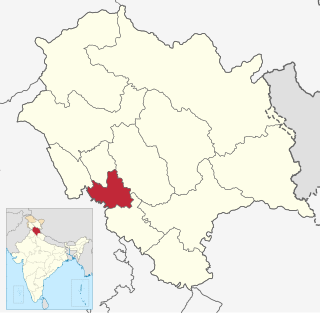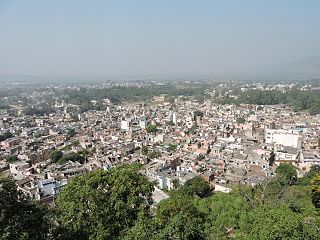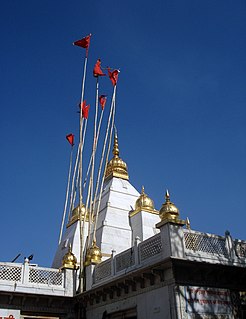
Himachal Pradesh is a state in the northern part of India. Situated in the Western Himalayas, it is one of the eleven mountain states and is characterized by an extreme landscape featuring several peaks and extensive river systems. Himachal Pradesh shares borders with the Union territories of Jammu and Kashmir and Ladakh to the north, and the states of Punjab to the west, Haryana to the southwest, and Uttarakhand and Uttar Pradesh to the south. The state shares an international border to the east with the Tibet Autonomous Region in China.

Shimla, also known as Simla, is the capital and the largest city of the Indian state of Himachal Pradesh. In 1864, Shimla was declared as the summer capital of British India. After independence, the city became the capital of Punjab and was later made the capital of Himachal Pradesh. It is the principal commercial, cultural and educational centre of the state. It was the capital city in exile of British Burma from 1942 to 1945.

Bilaspur is a town and a municipal council in Bilaspur district in the Indian state of Himachal Pradesh.

Bilaspur is a district of Himachal Pradesh, India. Its headquarters are in the town of Bilaspur. The district has an area of 1,167 km2, and a population of 381,956. As of 2011 it is the third least populous district of Himachal Pradesh, after Lahul and Spiti and Kinnaur.

Bhakra Dam is a concrete gravity dam on the Sutlej River in Bilaspur, Himachal Pradesh in northern India. The dam forms the Govind Sagar reservoir.

The Insurgency in Punjab

Nalagarh is a city and a municipal committee in Solan district in the Indian state of Himachal Pradesh.

Anandpur Sahib, sometimes referred to simply as Anandpur, is a city in Rupnagar district (Ropar), on the edge of Shivalik Hills, Indian state of Punjab. Located near the Sutlej River, the city is one of the most sacred places in Sikhism, being the place where the last two Sikh Gurus lived, Guru Teg Bahadur Ji and Guru Gobind Singh Ji. this is the place where Guru Gobind Singh founded the Khalsa Panth in 1699. The city is home to Kesgarh Sahib Gurdwara, one of the five Takhts in Sikhism.

Hamirpur is a town and the headquarters of Hamirpur district in the Himalayan state of Himachal Pradesh, India. Hamirpur is located in the Lower West Central Outer Himalayas at an average elevation of 790 M above sea level. Far northern High Altitude Dhauladhar Ranges overlook the city. Hamirpur is a rapidly developing City in Himachal Pradesh with New Entrepreneurship and Modern Construction. It is also a major junction on National Highway 3 While National Highway 103 starts at Here. Hamirpur is Famous for its High literacy rate, Educational Institutions and Traditional Festival Of Hamir Utsav. Hamirpur City is spread from Jhaniari to Bhota along NH 3 and NH 103 and is a prominent commercial centre for the district. It is Connected to the National Capital with regular HRTC Volvo and ordinary Buses. The nearest Airport is Kangra Airport and Mohali International Airport While the nearest Railway is in Una at 79 km. Hamirpur City is surrounded by Pine tree forests and has a good city infrastructure ranging from Quality Educational Institutions, NIT, State Universities and Skill Learning centres. Hamirpur is a great city.

Mata Naina Devi is a town and a municipal council in Bilaspur district in the Indian state of Himachal Pradesh.

Prem Kumar Dhumal is an Indian politician and was the Bharatiya Janata Party's Chief Ministerial candidate for the 2017 Himachal Assembly Election, in which he lost his seat. He previously served twice as Chief Minister of Himachal Pradesh, from March 1998 to March 2003 and again from 1 January 2008 to 25 December 2012.
The development of tribal areas in Himachal Pradesh is one of the major steps taken by the state government for its economic development. The border districts of Kinnaur, Lahaul, Spiti and the Pangi and Bharmour tehsils of Chamba districts are the major tribal areas of the state. They are located near the borders of Tibet and Indian States of Jammu and Kashmir. Other backward areas include Shillai in Sirmaur district, and deep cut-off valleys in the Kullu and upper stretches of Kangra districts. Due to poor accessibility, life in these areas had grown in isolation.

Captain Anurag Singh Thakur is a member of the Lower House of Parliament in India from Hamirpur in Himachal Pradesh, and also serves as a Minister of State for Finance and Corporate Affairs. He is the son of Prem Kumar Dhumal, the former Chief Minister of Himachal Pradesh. He was first elected to the Lok Sabha in May 2008 in a by poll as a candidate of the Bharatiya Janata Party. He is a four time MP, being a member of 14th, 15th, 16th, and 17th Lok Sabha. He was awarded the Sansad Ratna Award in 2019, an award established in 2010 by private organisations for recognizing contributions by parliamentarians.
A human stampede occurred on 30 September 2008, at the Chamunda Devi temple in Jodhpur, Rajasthan, India, in which 224 people were killed and more than 425 injured. The 15th-century temple is dedicated to the goddess Chamunda Devi and is located within the premises of Mehrangarh Fort.

Dehlan Lower, also spelled as Dahlan Lower, is a village located in Una district of the Indian state of Himachal Pradesh. Recently, Dehlan was adopted by Shri Anurag Singh Thakur, the sitting Member of Parliament from the Hamirpur seat under Sansad Adarsh Gram Yojna.

The Panjab Digital Library is a voluntary organization digitizing and preserving the cultural heritage of Panjab since 2003. With over 30 million digitized pages, it is the biggest resource of digital material on Panjab. There are many historically significant documents stored and made available online. Its scope covers Sikh and Punjabi culture. The library funded by The Nanakshahi Trust was launched online in August 2009. Its base office is located at Chandigarh, India.
Maghi is the regional name of the Hindu festival of Makar Sankranti celebrated in Punjab, Himachal Pradesh, Bihar and Nepal. In Himachal, the festival is also known as Maghi Saaji or Magha Ra Saza. In Bihar and Nepal it is also referred to as Maghi Parva or Maghi Sankranti. Maghi is celebrated on first day of the month of Magh of Hindu Calendar. It follows on the heels of the mid-winter festival of Lohri which is marked by bonfires in North Indian fields and yards. The next morning Hindus see as an auspicious occasion for ritual bathing in ponds and rivers.
Religion and spirituality, a pilgrimage is a long journey or search of great moral significance. Sometimes, it is a journey to a sacred place or shrine of importance to a person's beliefs and faith. Members of every major religion participate in pilgrimages. A person who makes such a journey is called a pilgrim.
Ajnol Village Located in the hills of Naina Devi, Ajnol is a small village that falls under the district of Bilaspur in Himachal Pradesh. It is quite popular because of the temple of Mata Naina Devi. This temple is one of the divine power hubs or 51 Shaktipeeths. It is a holy place and sees the arrival of thousands of pilgrims throughout the year.













